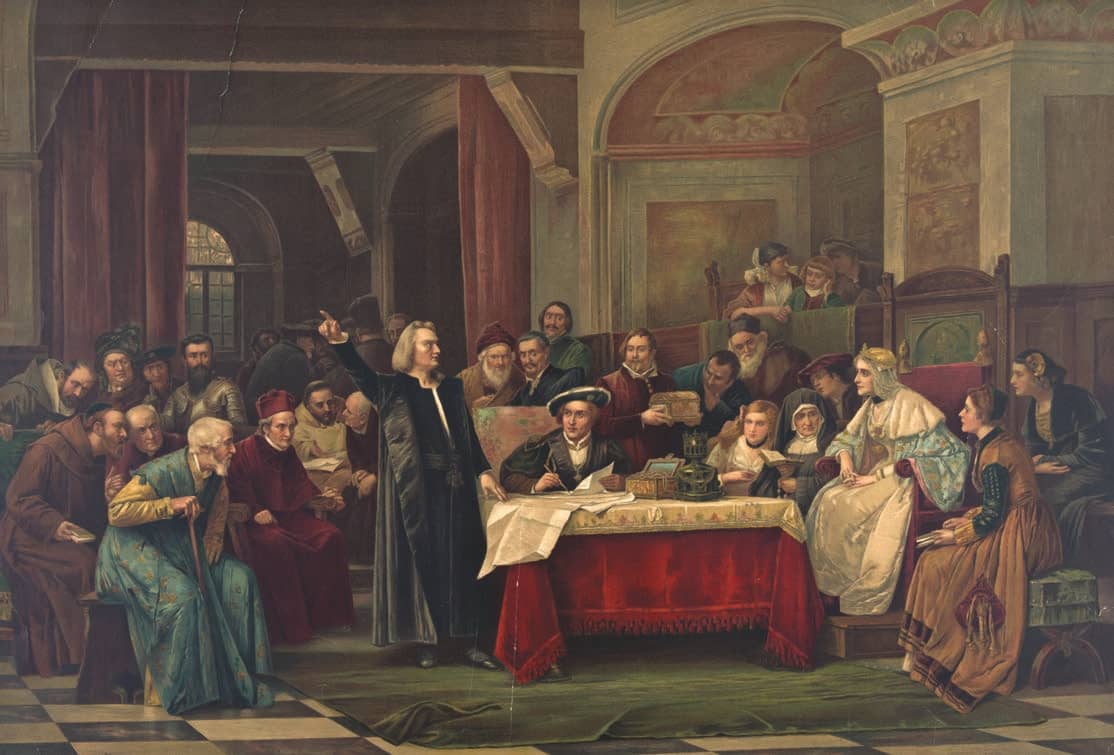
Those were the two main reasons why Spain’s King Ferdinand and Queen Isabella backed Christopher Columbus’s voyages. Columbus made four journeys across the Atlantic Ocean between 1492 and 1502. He didn’t find a trade route to India. Instead, he landed in the Americas. Thinking it was India, he called the land “the Indies” and the people there “Indians.” And he claimed the land for Spain.
Columbus also found gold. Gold was discovered in rivers on Hispaniola (present-day Haiti and the Dominican Republic), Cuba, and Puerto Rico. With money replacing barter as a way to do business, Europeans wanted precious metals. Those Caribbean islands on which Columbus first landed supplied Spain with an average of one ton of gold annually for many years before the supply gave out. But the Spanish rulers sought greater riches than that.
The Search Continues
In 1508, King Ferdinand opened the mainland of the Americas to Spanish exploration, conquest, and settlement. Conquistadors jumped at the opportunity. Vasco Núñez de Balboa had failed miserably at farming on Hispaniola. To escape his creditors, he stowed away on a ship bound for the northern coast of South America.
Balboa founded the first Spanish settlement on the American mainland—present-day Panama—in 1510. His tireless searches for gold led to the discovery of the Pacific Ocean in 1513. He also heard stories of a wealthy nation with plenty of gold that lay to the south. But when a rival accused him of treason, he was executed before he had a chance to look for those treasures.
Esta historia es de la edición January 2020 de Cobblestone American History Magazine for Kids.
Comience su prueba gratuita de Magzter GOLD de 7 días para acceder a miles de historias premium seleccionadas y a más de 9,000 revistas y periódicos.
Ya eres suscriptor ? Conectar
Esta historia es de la edición January 2020 de Cobblestone American History Magazine for Kids.
Comience su prueba gratuita de Magzter GOLD de 7 días para acceder a miles de historias premium seleccionadas y a más de 9,000 revistas y periódicos.
Ya eres suscriptor? Conectar

Eye in the Sky
An interview with Joe Piotrowski

Airborne Animals
Humans have taken to the skies in balloons, gliders, and airplanes-but we're not alone among the clouds. Animals of all sorts have evolved to harness wind power.

TAKING OFF
The Wright brothers expected airplanes to “take off,” but even they might be amazed at the way the airline industry has become big business. In the past, it was expensive to send something by plane.

GROWTH OF AN INDUSTRY
After their historic flight at Kitty Hawk in 1903, Wilbur and Orville Wright returned to Dayton, Ohio. They spent the next few years making adjustments and building additional versions of their powered aircraft in their bicycle shop.

WHY KITTY HAWK?
The Wright brothers searched carefully for the best place to test their gliders and flying machines. Their main concern was for good, steady winds. But they also hoped to find a remote location to allow them to perform tests away from the public eye.

Two Brothers From Ohio
Most people do not realize that the Wright brothers—Wilbur, born in 1867, and Orville, born in 1871—performed various scientific experiments before inventing their aircraft. For as long as anyone in their hometown of Dayton, Ohio, could remember, the Wright boys had worked on mechanical projects.

A Helping Hand
May 6, 1896. A group of people who had gathered beside the Potomac River, just south of the U.S. capital, grew quiet. Then, it erupted in cheers as a small, unmanned aircraft took to the skies and flew for more than half a mile. The flight came seven years before the Wright brothers’ first manned, powered flight. The inventor of the aircraft was Dr. Samuel Pierpont Langley.

THE IDEA MEN
People dreamed of flying thousands of years before the Wright brothers found success near Kitty Hawk, North Carolina. These dreamers, such as Leonardo da Vinci, studied birds flying and imagined how humans might do the same—if only they had wings. Other men developed a more hands-on approach to the topic. Early inventors made wings of cloth, glue, and feathers and tied these creations to their arms in an attempt to imitate nature.

Da Vinci's 4 Designs
Have you ever wondered how a bird flies? Leonardo da Vinci (1452–1519) did. He thought that understanding how a bird flies would provide the key to human flight. So, what did da Vinci learn from birds?

Silken Wings
Seven hundred years before the Wright brothers began experimenting with human flight, the Chinese had already mastered its secrets—with kites.